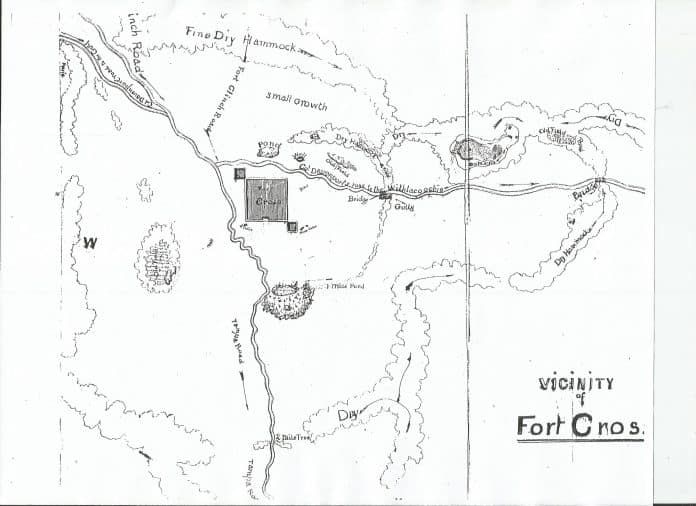Established on December 2, 1838, Fort Cross operated until the end of the Second Seminole War in 1842. Historians say the site is located on a plot of land owned by the Graddy family on Wiscon Road near Bravera Health Brooksville. The fort was discovered and largely excavated by a collector and historian named Glenn Nickens in the 1990’s. It is believed to have resided on the property on the south side of a small pond and the southeast side of the intersection of two military roads.
With permission from the property owner, Alma Graddy, these excavators pulled thousands of artifacts from the ground. Historians Jesse Marshall and Butch Nipper later met with Mr. Nickens at the site between 2012 and 2013. He informed the two how the artifacts discovered pointed to the presence of a Seminole war era military site. That meeting led to the Historic Hernando Preservation Society’s recording of the land as the home to Fort Cross. Jon Yeager, a former member of the preservation society, filed an updated report for the Florida Master Site File with the Department of Historical Resources in 2013.
The fort was built as part of a system of 155 military outposts distributed in a grid across Florida through 1868. This was part of then-Colonel Zachary Taylor’s plan to settle and protect land in the state. As one of three main forts in Hernando County, Fort Cross played a large role in establishing the area. It served as a supply depot in addition to being a deterrent against attacks by the native Seminole population.
According to Sean Norman, the Director of the Gulf Archaeological Research Institute, Forts Annutteliga and Desoto failed to last long due to a lack of freshwater and other factors. This left Fort Cross with a significant part to play in the history of Brooksville.
“But [Fort Cross] sort of is involved with the foundation of the town of Brooksville,” said Sean Norman. “You got the historic town of Chocachatti… is founded by a group of settlers, John Curry. And that’s sort of done with the aid of the facilities and troops of Fort Cross. So, it’s like kind of out of the three, essentially the most important for essentially the history of Hernando County.”
Norman feels the documentation and conservation of the site is significant for Hernando, as the county has a less than stellar record regarding preservation as a whole. He remarked that a county like Citrus has significantly more in comparison to Hernando as Citrus contains the Crystal River Mound and Fort Cooper sites.
“Hernando County has a very, very poor record on historic preservation overall,” said Norman. “There is very little of that in Hernando County.”
The status of the land is now a pressing issue as construction is due to begin in the immediate vicinity around the site. Meritage Homes of Florida is currently planning to build a development in the area and requested the land be rezoned from multi-family to single family with deviations. In a press release from Jan Knowles, the president of the Historic Hernando Preservation Society, she noted that her organization and the contractors had reached an agreement in preserving the land.
The release stated the two sides “would work together to make sure that there would be some sort of recognition of the historic site… On June 14 the partitioners appeared before the County commission for final approval. Someone from our organization was there also. Again, it was agreed that the builders/owners would work with HHPS concerning the historic site to be able to recognize Fort Cross.”
According to Director Norman, there are also often “Seminole components” to these types of military forts. This means that they tended to be built directly on land that had been cleared and cultivated by native Seminoles. So, in saving a historic site that was influential in the founding of Brooksville, they are also likely to be preserving land that was once settled by Seminoles.
An additional document from President Knowles lists other “cultural resources” contained in the Meritage Homes plan. These include more military encampments relating to the fort, prehistoric Archaic period materials, and the aforementioned “Seminole components.” This release recommends that a 2.5-acre area be set aside for a passive park to lessen the impact on the site itself, generally avoiding the densest clustering of materials.
“To support and encourage ongoing interest,” says the mission statement of the HHPS “and research relating to the history of the original Hernando County, Florida, including aspects of Archeology, Architecture and Culture of current day Hernando, Citrus and Pasco Counties.”

